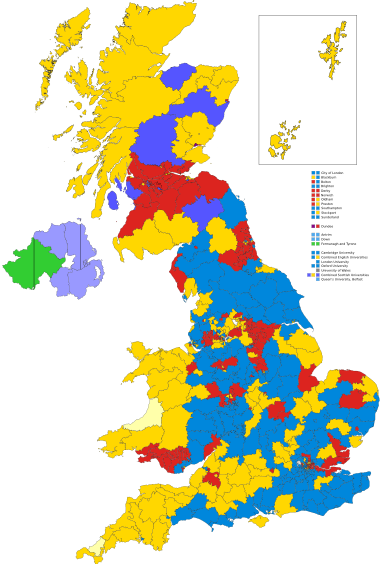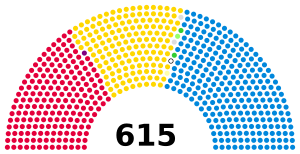1923 United Kingdom general election facts for kids
|
|||||||||||||||||||||||||||||||||||||||||||||
|
|
|||||||||||||||||||||||||||||||||||||||||||||
|
All 615 seats in the House of Commons 308 seats needed for a majority |
|||||||||||||||||||||||||||||||||||||||||||||
|---|---|---|---|---|---|---|---|---|---|---|---|---|---|---|---|---|---|---|---|---|---|---|---|---|---|---|---|---|---|---|---|---|---|---|---|---|---|---|---|---|---|---|---|---|---|
| Turnout | 71.1%, |
||||||||||||||||||||||||||||||||||||||||||||
|
|||||||||||||||||||||||||||||||||||||||||||||

Colours denote the winning party—as shown in 1923 United Kingdom general election § Notes
|
|||||||||||||||||||||||||||||||||||||||||||||
|
|||||||||||||||||||||||||||||||||||||||||||||
The 1923 United Kingdom general election took place on Thursday, 6 December 1923. The Conservatives, led by Prime Minister Stanley Baldwin, won the most seats. However, the Labour Party, led by Ramsay MacDonald, and H. H. Asquith's reunited Liberal Party gained many seats. This resulted in a hung parliament, meaning no single party had enough seats to form a government on its own.
This election was the last time a "third party" (not Conservative or Labour) won over 100 seats. The Liberal Party's share of the vote, 29.7%, has not been beaten by a third party in any general election since. After the election, Ramsay MacDonald formed the very first Labour government. The Liberals supported him, hoping Labour would struggle and lose popularity quickly. Because it was a minority government, it only lasted ten months. Another general election was held in October 1924.
Contents
Understanding the 1923 UK Election
Why the Election Happened So Soon
In May 1923, the Prime Minister, Bonar Law, became very ill. He resigned on 22 May, after being in office for only 209 days. Chancellor of the Exchequer, Stanley Baldwin, took his place. The Labour Party also got a new leader, Ramsay MacDonald, who replaced J. R. Clynes.
Baldwin's Conservative Party had won the election just the year before. They had a strong majority in the House of Commons and could have waited four more years. But Baldwin felt he needed to ask the public for their support again. He wanted a clear "mandate" (permission from the voters) to introduce new trade policies. These policies were called tariff reform and imperial preference. They aimed to protect British industries by adding taxes to goods from other countries. Some people in his own party disagreed with these ideas, as they preferred free trade (trading without taxes or limits).
Challenges Facing the Country
Britain was facing tough times. The country had to pay a large debt to the United States every year. French troops were still in a part of Germany called the Ruhr. There were also problems with high unemployment and strikes by workers.
Because of these difficulties, Baldwin believed that Britain's economy needed big changes. He decided to call an early election to get public support for his new trade plans.
The Election's Surprising Outcome
Parliament was officially closed on 16 November to prepare for the election. However, Baldwin's plan did not work out as he hoped. His party lost many seats to both Labour and the Liberals. This led to a hung parliament, where no single party had enough Members of Parliament (MPs) to form a government on their own.
It was not possible to bring back the old Conservative-Liberal partnership. Baldwin had upset the two main Liberal leaders, Asquith and David Lloyd George. So, the Liberals had to choose: support a minority Conservative government or a minority Labour government.
In the end, Asquith chose to support Labour. One reason was that Lloyd George's group strongly opposed working with Baldwin. Another reason was that Asquith believed Labour's success was partly due to the Liberals being split before. He thought that if Labour formed a government, their policies would fail. This would then allow the Liberals to become the stronger party in the next election.
So, the Liberals joined with Labour to vote against Baldwin's government plan (called the King's Speech). This caused Baldwin's government to fall. For the first time in British history, the Labour Party formed a government.
Election Results and Party Performance
| Candidates | Votes | ||||||||||
|---|---|---|---|---|---|---|---|---|---|---|---|
| Party | Leader | Stood | Elected | Gained | Unseated | Net | % of total | % | No. | Net % | |
| Conservative | Stanley Baldwin | 536 | 258 | 23 | 109 | −86 | 41.95 | 38.0 | 5,286,159 | −0.5 | |
| Labour | Ramsay MacDonald | 427 | 191 | 64 | 15 | +49 | 31.06 | 30.7 | 4,267,831 | +1.0 | |
| Liberal | H. H. Asquith | 457 | 158 | 86 | 43 | +43 | 25.69 | {{{votes %}}} | 4,129,922 | +0.9 | |
| Nationalist | Joseph Devlin | 2 | 2 | 0 | 0 | 0 | 0.3 | 0.3 | 43,835 | N/A | |
| Independent | N/A | 6 | 2 | 0 | 1 | −1 | 0.325 | 0.3 | 36,802 | −0.5 | |
| Communist | Albert Inkpin | 4 | 0 | 0 | 1 | −1 | 0.2 | 34,258 | 0.0 | ||
| Belfast Labour | David Robb Campbell | 1 | 0 | 0 | 0 | 0 | 0.2 | 22,255 | N/A | ||
| Independent Labour | N/A | 4 | 0 | 0 | 1 | −1 | 0.2 | 17,331 | 0.0 | ||
| Independent Liberal | N/A | 4 | 1 | 1 | 1 | 0 | 0.1 | 0.1 | 16,184 | 0.0 | |
| Constitutionalist | N/A | 1 | 0 | 0 | 1 | −1 | 0.1 | 15,500 | 0.0 | ||
| Ind. Conservative | N/A | 1 | 0 | 0 | 3 | −3 | 0.1 | 15,171 | −0.8 | ||
| Scottish Prohibition | Edwin Scrymgeour | 1 | 1 | 0 | 0 | 0 | 0.1 | 12,877 | 0.0 | ||
| Irish Nationalist | N/A | 2 | 1 | 0 | 0 | 0 | 0.2 | 0.1 | 10,322 | N/A | |
| Christian Pacifist | N/A | 1 | 1 | 1 | 0 | 0 | 0.0 | 570 | N/A | ||
How People Voted
| Popular vote | ||||
|---|---|---|---|---|
| Conservative | 38.01% | |||
| Labour | 30.68% | |||
| Liberal | 29.69% | |||
| Others | 1.62% | |||
Seats Won by Parties
| Parliamentary seats | ||||
|---|---|---|---|---|
| Labour | 31.06% | |||
| Conservative | 41.95% | |||
| Liberal | 25.69% | |||
| Others | 1.30% | |||
Detailed Results for Each Area
See also
- List of MPs elected in the 1923 United Kingdom general election
- 2019 United Kingdom general election, the next UK general election after 1923 to be held in December.
- 1923 United Kingdom general election in Northern Ireland





